The Tiny Seed

by Eric Carle. ![]() Picture Book. 36 pages. Grades PreK-2.
Picture Book. 36 pages. Grades PreK-2.
Find this book: Amazon

Teacher's Guide
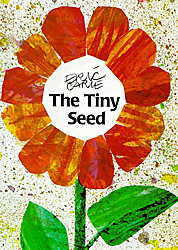
It's fall and seeds are being blown along by the wind. The seeds travel on a perilous journey: one of the bigger seeds is burned by the sun, another falls into the ocean, and one is eaten by a bird. Even for the seeds that land on fertile ground and begin to grow, the danger is not over. A new sprout is stepped on and a small plant is carelessly picked. One tiny seed keeps growing and the ending is a happy one: survival in the face of overwhelming obstacles. This classic, first published in 1970, is a great introduction to the life-cycle of flowering plants and also a beautiful philosophical look at life.
Carle's signature collages use handmade colorful swatches of paper. His inventiveness with materials is the visual mainstay of his illustrations. In this early work, as in his later illustrations, he explores the endless possibilities of colors, shapes and textures, combining cut paper, sponged colors and spatter paint for exciting collage combinations.
(Continued Below)
Advertisement:

Things to Talk About and Notice
- Math:
- Spatial Relationships:
- Use the illustrations to point out spatial relationships. "The seeds are over the ocean," "The seeds are under the snow," "Where are the seeds now?"
- Spatial Relationships:
- Language Arts:
- Vocabulary: Adjectives
- Look for the adjectives on each page, for each season and try to think of other words the author might have used that mean the same thing. Which word would you choose?
- Verb Tense
- The story is written in the present tense. Read some passages as if the story happened a while ago.
- Vocabulary: Adjectives

Activities
- Science:
- Plants:
- Go on a collecting walk to gather wild seeds in the fall. See how many different kinds of seeds you can find.
- See if you can decide how the seed got to that particular place. If the seeds are still on the plant see if you can guess how they might be dispersed.
- Categorize your seeds when you get back to the classroom.
- Go on a collecting walk to gather wild seeds in the fall. See how many different kinds of seeds you can find.
- Put an old wooly sock on over your shoe. Walk in brushy areas or through a field of long grasses so that seeds will cling to your sock. Plant the sock in rich dirt. Water it and see what happens. Can you identify your plants?
- Chart the lifecycle of the seed in the book noticing the cyclical pattern. What are some other cyclical patterns that exist in nature?
- Make a list of edible seeds.
- Cut a lima bean seed open and examine the tiny plant inside. Then plant another bean seed in a glass jar, putting it between the glass and damp absorbent paper. Chart its growth.
- Plant four seeds. To demonstrate the needed conditions and environment, give one the necessary sun, water and good soil. Deprive each of the others of one element. Keep a daily picture journal.
- Plants:
- Subtraction:
- Count the seeds that begin the journey in autumn. Subtract one seed that cannot grow and write a number equation: 10 - 1 = ? Do the same for each seed that failed to grow until you get to the five that sleep through the winter.
Begin again in the spring to subtract one plant that cannot live and write the number equation.
Continue subtracting until one tiny seed has grown into a very tall flower and is the only one remaining.
- Count the seeds that begin the journey in autumn. Subtract one seed that cannot grow and write a number equation: 10 - 1 = ? Do the same for each seed that failed to grow until you get to the five that sleep through the winter.
(Continued Below)
Advertisement:

Related Books
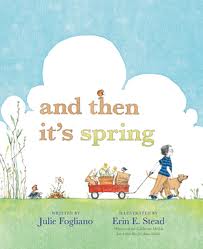 And Then It's Spring by Julie Fogliano. Illustrated by Erin E. Stead. (2012, Roaring Brook. ISBN 9781596436244.) Picture Book. 32 pages. Gr PreK-2.
And Then It's Spring by Julie Fogliano. Illustrated by Erin E. Stead. (2012, Roaring Brook. ISBN 9781596436244.) Picture Book. 32 pages. Gr PreK-2.
Find this book: Local Bookstore, Amazon, B&N
A boy and his dog plant some seeds, and wait, and wait. It seems everything will always be brown until suddenly, "It's Spring!" The tone here is quiet, almost solemn. A beautifully crafted story illustrated by Caldecott Award winner Erin E. Stead.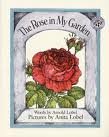 The Rose in My Garden by Arnold Lobel. Illustrated by Anita Lobel. (1993, Greenwillow. ISBN 9780688122652.) Picture Book. 40 pages. Gr PreK-3.
The Rose in My Garden by Arnold Lobel. Illustrated by Anita Lobel. (1993, Greenwillow. ISBN 9780688122652.) Picture Book. 40 pages. Gr PreK-3.
Find this book: Local Bookstore, Amazon, B&N
Another "This is the House That Jack Built" using the combined skills of Arnold and Anita Lobel tells of a simple incident in a garden. The words will stretch and the illustrations will delight. There are wonderful descriptive words for each flower in the garden, some varieties of which will be unfamiliar to many children. This Year's Garden by Cynthia Rylant. Illustrated by Mary Szilagyi. (1987, Aladdin. ISBN 9780689711220.) Picture Book. 32 pages. Gr K-3.
This Year's Garden by Cynthia Rylant. Illustrated by Mary Szilagyi. (1987, Aladdin. ISBN 9780689711220.) Picture Book. 32 pages. Gr K-3.
Find this book: Local Bookstore, Amazon, B&N
Adults and children survey the garden and make appropriate plans. The adults discuss what to plant this spring while the children anticipate the fun of working in the garden. Warm weather comes at last and the crop is readied. We follow the garden's year.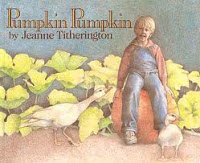 Pumpkin Pumpkin by Jeanne Titherington. (1986, Greenwillow. ISBN 9780688056957.) Picture Book. 24 pages. Gr PreK-3.
Pumpkin Pumpkin by Jeanne Titherington. (1986, Greenwillow. ISBN 9780688056957.) Picture Book. 24 pages. Gr PreK-3.
Find this book: Local Bookstore, Amazon, B&N
Jamie plants a pumpkin seed and we follow the life-cycle of the plant through the carving of a jack-o'-lantern and back to the planting of another seed. The soft illustrations give this book an air of tenderness.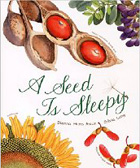 A Seed Is Sleepy by Dianna Hutts Aston. Illustrated by Sylvia Long. (2007, Chronicle. ISBN 9780811855204.) Picture Book. 28 pages. Gr 2-8.
A Seed Is Sleepy by Dianna Hutts Aston. Illustrated by Sylvia Long. (2007, Chronicle. ISBN 9780811855204.) Picture Book. 28 pages. Gr 2-8.
Find this book: Local Bookstore, Amazon, B&N
This is a gorgeous picture book from the same author/illustrator team that brought us An Egg Is Quiet. We start with a beautiful opening page spread showing sunflower seeds nestled within the center of a ripe sunflower head. Beautiful illustrations show seeds next being secretive (lying dormant for a season or for years), fruitful (encased in blueberries and papayas) and so on. Read More.
 Grades 2 - 9
Grades 2 - 9
The Art of Eric Carle by Eric Carle. Nonfiction. 128 pages.
Find this book: Local Bookstore, Amazon, B&N
This is a wonderful source book for information about Eric Carle and his work. Carle includes a delightful autobiography amply illustrated with photographs and sketches, but there is much more in the book. An editor relates her experiences with Carle. There's a section about the way he creates his work and writings by Carle and some of his colleagues. Best of all, the book is a compendium of his artwork.
(Continued Below)
Advertisement:

Related Areas Within Carol Hurst's Children's Literature Web Site
- Author Study of Eric Carle
- All our Featured Book Articles
Teachers Guides with reviews, activities, related books, and links. - The Very Quiet Cricket by Eric Carle. Teachers Guide with activities, related books and links.
- The Very Hungry Caterpillar by Eric Carle. Book Review.
- Parts of this article are excerpted from Picture Book Math:
Using Picture Books in the Math Curriculum, Prekindergarten through Third Grade
An eBook by Carol Hurst and Rebecca Otis. Available for instant download. - Free Teacher's Guides: A listing of all our teacher's guides. Picture Books, Nonfiction and Fiction.

